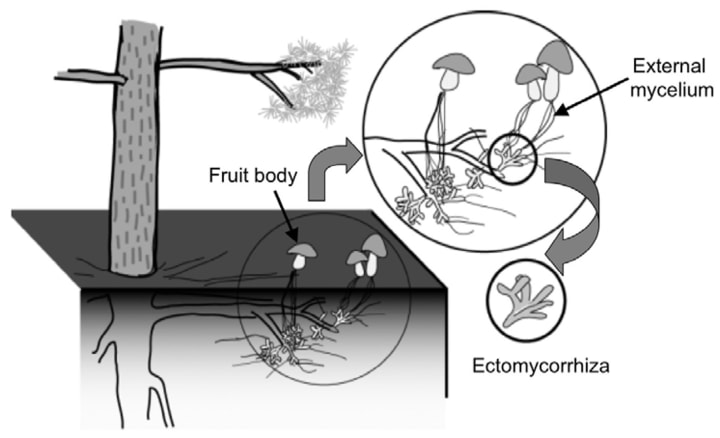WTF are mycorrhizal fungi?
Different types of fungi for the curious nature lover

What are mycorrhizal fungi?
Mycorrhizal fungi are a type of fungus that form a symbiotic relationship with plant roots. This relationship is known as mycorrhiza, and it is beneficial for both the fungi and the plant. The fungi provide the plant with nutrients, such as phosphorus and nitrogen, in exchange for carbohydrates produced by the plant through photosynthesis. Mycorrhizal fungi are found in a wide range of ecosystems, and they play an important role in the health and functioning of these ecosystems.
Types of mycorrhizal fungi:

Endomycorrhizae, also known as arbuscular mycorrhizae, are a type of mycorrhizal association between fungi and the roots of most plant species. The fungi penetrate the cells of the plant root and form specialized structures called arbuscules, which are tree-like structures that extend into the plant cells. They are mutualistic, meaning that both the plant and the fungus benefit from the association. The fungus provides the plant with nutrients such as phosphorus, nitrogen, and other micronutrients, which are often scarce in soil. In exchange, the plant provides the fungus with carbohydrates and other nutrients. Endomycorrhizae are found in almost all terrestrial ecosystems and are very important for plant growth and survival. They are particularly important in nutrient-poor soils, such as those found in tropical rainforests, where they can significantly enhance plant growth and productivity.
Ectomycorrhizal fungi form a sheath around the roots of plants, and they are commonly found in forests. These fungi are particularly important for the health of trees, as they help them absorb nutrients, such as phosphorus and nitrogen, from the soil. In addition, ectomycorrhizal fungi can help prevent soil erosion and improve soil structure.
Ectendomycorrhizae are a type of mycorrhizal association that exhibit both ectomycorrhizal and arbuscular mycorrhizal characteristics. It is a relatively rare and recently discovered type of mycorrhiza. In ectendomycorrhizae, the fungal hyphae form a sheath around the root tip, similar to ectomycorrhiza. However, the fungal hyphae also penetrate the root cells and form arbuscules, which is a characteristic of arbuscular mycorrhizae. This combination of features allows the fungus to access both organic and inorganic sources of nutrients, making it beneficial for the host plant. They have been found in a range of plant species, including some trees, shrubs, and herbs. They are particularly common in environments with high levels of disturbance, such as mine tailings or volcanic soils, where they may help plants to establish and grow in nutrient-poor soils.
Examples of the uses of mycorrhizal fungi:
Forests:
Mycorrhizal fungi play a crucial role in the health and functioning of forests. Ectomycorrhizal fungi are particularly important for the growth and survival of trees, as they help them absorb nutrients from the soil. In addition, mycorrhizal fungi are important for the cycling of nutrients within the forest ecosystem, as they break down organic matter and release nutrients that are then available for plant uptake. Mycorrhizal fungi can also help prevent soil erosion and improve soil structure, making it more suitable for plant growth.
Examples include: Amanita muscaria, Boletus edulis, and Suillus luteus.

Grasslands:
Mycorrhizal fungi are found in a wide range of grassland ecosystems, and they play an important role in improving soil fertility and plant growth. Arbuscular mycorrhizal fungi are particularly important in grasslands, as they help plants tolerate environmental stressors such as drought and nutrient deficiency. In addition, mycorrhizal fungi can help increase the biodiversity of grassland ecosystems, as they establish symbiotic relationships with a wide range of plant species.
Examples: Rhizophagus irregularis, Funneliformis mosseae, Acaulospora laevis, Claroideoglomus etunicatum, and Gigaspora margarita.
Wetlands:
Mycorrhizal fungi are also found in wetland ecosystems, where they play an important role in improving soil fertility and plant growth. Arbuscular mycorrhizal fungi are particularly important in wetlands, as they help plants tolerate environmental stressors such as flooding and nutrient deficiency. In addition, mycorrhizal fungi can help prevent soil erosion and improve soil structure in wetland ecosystems.
Examples: Glomus intraradices, Funneliformis geosporum, Rhizophagus clarus, Acaulospora scrobiculata, and Scutellospora calospora.
References
Satomura, Takami & Hashimoto, Yasushi & Kinoshita, Akihiko & Horikoshi, Takao. (2006). Methods to study the role of ectomycorrhizal fungi in forest carbon cycling 1: Introduction to the direct methods to quantify the fungal content in ectomycorrhizal fine roots. Root Research. 15. 119-124. 10.3117/rootres.15.119.
About the Creator
fungal earthling
I write techno songs. I also feel deeply about things. You can find my free flowing feelings here.






Comments
There are no comments for this story
Be the first to respond and start the conversation.